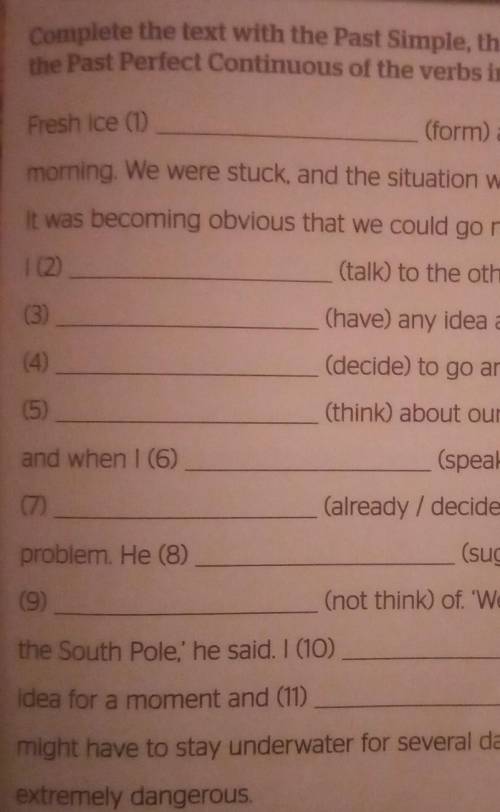Complete the text with the Past Simple, the Past Perfect Simple or the Past Perfect Continuous of the verbs in brackets.
Fresh Ice (1)
(form) around the Nautilus all
morning. We were stuck, and the situation was getting worse,
It was becoming obvious that we could go no further south.
(talk) to the other sailors but nobody
(have) any idea about how to escape
(decide) to go and see Captain Nemo. He
(think) about our situation for some time,
are when I (6)
(speak) to him, he
(already / decide) how to solve the
(suggest) something which!
(not think of. 'We will sail under the ice to
problem. He (8)
(think) about the
the South Pole,' he said. I (10)
(reallse) that we
Idea for a moment and (11)
might have to stay underwater for several days. It would be
extremely dangerous

Другие вопросы по теме Английский язык
Популярные вопросы
- Каким должен быть настоящий мужчина-сравнить с персонажами из книг...
3 - Первую треть пути турист за 2,7 часа со скоростью 4 км/ч. вторую треть на 1 км/ч...
2 - Невелике висловлювання на тему з ким я хотіла б дружити...
2 - Среднее арифметическое четыёх чисел 6, 7 . первое равно 2 , второе в 1, 2 раза...
3 - Идут ли эти реакции, если да, то напишите эти уравнения hg+h2o- ca+hci- ni+pbso4-...
1 - 50 пунктов за 1. к и р соответственно середины сторон ав и вс треугольника авс,...
2 - Найди значения выражений 6*3-12/2+48...
1 - Распредели слова в соответствии с их составом: смотрим, промок, зеленый, подножка,...
3 - Землеройная машина за 1 ч вынула 3060(м кубических) грунта,оставляя за собой траншею...
1 - Твір на тему якою людиною я хотіла б стати в майбутньому ( мається на увазі характер)....
2
Explanation:
1. "Fresh Ice had been forming" - We use the Past Perfect Continuous (had been forming) to indicate an action that started in the past and continued up until another point in the past (all morning).
2. "talked to" - We use the Past Simple (talked) to refer to a past action that is completed.
3. "had" - We use the Past Perfect Simple (had) to indicate an action that happened before another action in the past.
4. "decided" - We use the Past Simple (decided) to refer to a specific past action (Captain Nemo's decision).
5. "had been thinking" - We use the Past Perfect Continuous (had been thinking) to indicate an action that started in the past and continued up until another point in the past (when I spoke to him).
6. "spoke" - We use the Past Simple (spoke) to refer to a past action that is completed.
7. "had already decided" - We use the Past Perfect Simple (had already decided) to indicate an action that happened before another action in the past.
8. "suggest" - We use the Past Simple (suggest) to refer to a specific past action (Captain Nemo's suggestion).
9. "had not thought" - We use the Past Perfect Simple (had not thought) to indicate an action that happened before another action in the past.
10. "realized" - We use the Past Simple (realized) to refer to a past action that is completed.
11. "had" - We use the Past Perfect Simple (had) to indicate an action that happened before another action in the past.
12. "had" - We use the Past Perfect Simple (had) to indicate an action that happened before another action in the past.
13. "might have" - We use "might have" to indicate a possible action in the past.
14. "had" - We use the Past Perfect Simple (had) to indicate an action that happened before another action in the past.
15. "would be" - We use "would be" to refer to a future possibility in the past.